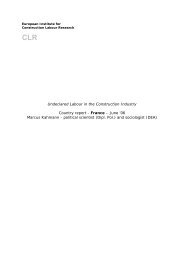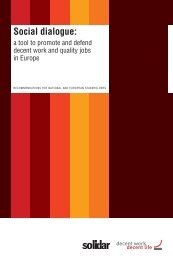Japan – what can we learn? - Construction Labour Research
Japan – what can we learn? - Construction Labour Research
Japan – what can we learn? - Construction Labour Research
You also want an ePaper? Increase the reach of your titles
YUMPU automatically turns print PDFs into web optimized ePapers that Google loves.
Immigration law allows residential visas for spouses of <strong>Japan</strong>esenationality and second and third generation descendants of <strong>Japan</strong>eseancestors and their spouses. Also in 1990 the Industrial TrainingProgram for foreign trainees was established, which is supported bythe semi-official organisation of the <strong>Japan</strong> International TrainingCooperation Organization (JITCO)). The importance of this newsystem it that it opens the way for small and medium sized firms toaccept immigrant workers legally. The conditions are that a firm withless than 50 employees <strong>can</strong> accept 3 foreign trainees per year, so ifthey accept every year, the maximum is to be 9 trainees at a time. 80%of trainees come from China, 72% youngsters of 20 years old.As a result of the transformation in 1990, the composition of foreignresidents according to nationality changed dramatically, with <strong>Japan</strong>eseBrazilians, other South Ameri<strong>can</strong>s and Asians rapidly increasing.Many <strong>Japan</strong>ese Brazilians and other South Ameri<strong>can</strong>s have enteredthe manufacturing industry as employees of contracting agencies.Compared to these legal residents, it is difficult to estimate how manymigrant workers work in construction. During the late 1980s, it hasoften been reported that many South and Southeast Asians worked inconstruction as undocumented workers. On the basis of available datafrom the Immigration Bureau, the recent estimate is 40,000, which isonly 0.7% of the construction workforce. 80% of these foreignconstruction workers have the status of undocumented workers with20% having the status of “trainee”. The estimated number ofundocumented migrants has been decreasing along with thegovernmental strengthening of deportation policy.6. ConclusionThese days the <strong>Japan</strong>ese construction industry faces a critical turningpoint. It becomes evident that the conventional government-initiatedsystem <strong>can</strong> no longer sustain institutional regulation under pressuresfor structural reform. This also means that the industry is forced tomove away from its dependency on development policy after theWWII and turn to the sustainable adjustment of the industry. At thispoint, I insist that the most urgent challenge is not simply to establishfair labour standards but to ask how to create the arena whereby eachagency <strong>can</strong> discuss the same issue.CLR News No 2/200644









